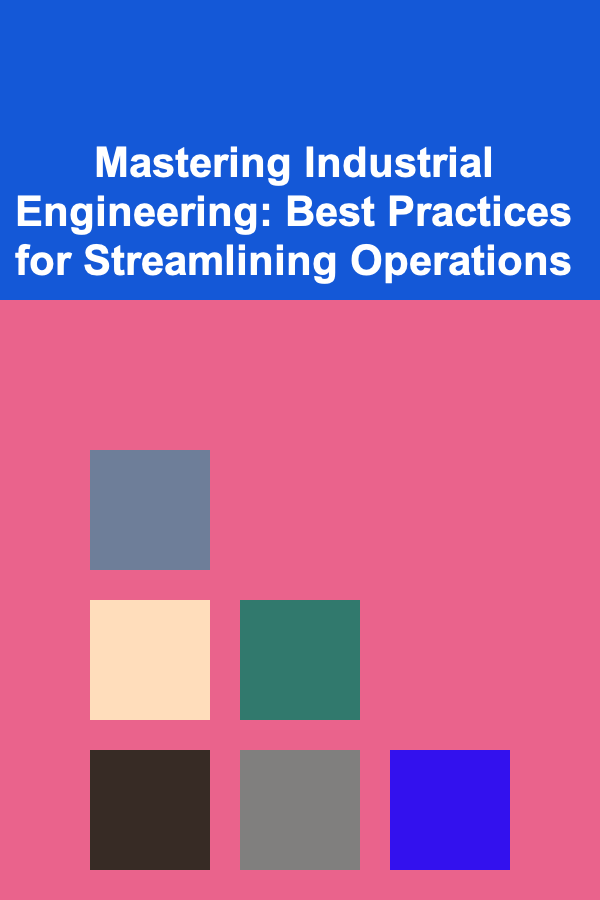
Mastering Industrial Engineering: Best Practices for Streamlining Operations
ebook include PDF & Audio bundle (Micro Guide)
$12.99$6.99
Limited Time Offer! Order within the next:

Industrial engineering (IE) plays a critical role in improving the efficiency and effectiveness of manufacturing and service operations. By applying a combination of engineering principles, management strategies, and mathematical techniques, industrial engineers can streamline operations, reduce waste, and optimize processes. Whether in manufacturing, healthcare, or logistics, mastering industrial engineering practices can result in higher productivity, reduced costs, and a more sustainable operation.
This actionable guide explores best practices that industrial engineers can adopt to streamline operations, focusing on process optimization, resource management, technology integration, and continuous improvement.
Understanding the Core Principles of Industrial Engineering
Before diving into best practices, it's essential to establish a solid foundation of what industrial engineering entails. The key goal of industrial engineering is to design, analyze, and improve complex systems that involve human, machine, material, information, and energy components. This encompasses everything from optimizing production lines to improving service delivery in non-manufacturing environments.
Industrial engineers focus on:
- Process optimization: Making systems more efficient by eliminating waste, reducing unnecessary steps, and improving throughput.
- Quality control: Ensuring consistent product quality through standardized processes.
- Resource management: Maximizing the use of resources such as labor, materials, and equipment.
- Systems thinking: Understanding how all parts of a process are interrelated and optimizing the system as a whole.
Best Practices for Streamlining Operations
1. Implement Lean Manufacturing Principles
Lean manufacturing is a methodology focused on eliminating waste and improving efficiency in production processes. Industrial engineers can implement Lean techniques to optimize production lines and minimize operational costs. Key Lean practices include:
Value Stream Mapping (VSM)
VSM is a tool used to analyze the flow of materials and information through a production process. By mapping out the entire process, industrial engineers can identify bottlenecks, delays, and non-value-added activities. This helps engineers redesign workflows to eliminate inefficiencies.
5S Methodology
The 5S approach focuses on organizing and standardizing the workplace to improve efficiency. It stands for Sort, Set in Order, Shine, Standardize, and Sustain. By maintaining a clean and organized work environment, the likelihood of errors is reduced, and workers can focus on value-added tasks rather than spending time searching for tools or materials.
Continuous Flow and Pull Systems
In a continuous flow system, products move seamlessly from one stage to the next without interruption. Pull systems, such as Kanban, ensure that production is driven by actual demand rather than forecasted demand. This helps reduce overproduction, excess inventory, and unnecessary work.
Kaizen (Continuous Improvement)
Kaizen promotes incremental, ongoing improvements in processes. By involving employees at all levels in suggesting and implementing small changes, industrial engineers can foster a culture of continuous improvement. This ensures that the operation is always evolving toward greater efficiency.
2. Adopt Six Sigma Methodology for Quality Control
Six Sigma is a data-driven methodology focused on reducing process variability and defects to improve product quality. The core of Six Sigma is the DMAIC process (Define, Measure, Analyze, Improve, Control). Industrial engineers can use Six Sigma to enhance process performance and reduce defects.
Define
The first step in Six Sigma involves clearly defining the problem and understanding customer needs. For example, a manufacturing plant might identify that a significant percentage of products fail to meet quality standards.
Measure
In this phase, data is collected to measure the current state of the process. Key performance indicators (KPIs) are used to assess the quality of products or services. The goal is to understand the root causes of defects or inefficiencies.
Analyze
The analysis phase involves identifying the causes of defects or inefficiencies. Industrial engineers may use techniques such as cause-and-effect diagrams, statistical analysis, or Pareto charts to pinpoint the sources of variability.
Improve
Once the root causes have been identified, engineers can brainstorm and implement solutions to address them. This could involve redesigning processes, introducing new equipment, or applying process changes.
Control
Finally, the control phase ensures that improvements are sustained over time. Engineers may implement control charts or process monitoring systems to track performance and make adjustments as needed.
3. Optimize Resource Management
Effective resource management is at the heart of streamlining operations. Industrial engineers must ensure that resources such as labor, equipment, and materials are used efficiently to avoid waste and reduce operational costs.
Capacity Planning
Industrial engineers can use capacity planning to determine the optimal production level for a system, balancing supply and demand. By forecasting future demand and evaluating current production capacity, engineers can ensure that resources are allocated effectively and avoid overproduction or bottlenecks.
Equipment Maintenance and Reliability
Regular maintenance and proper care of equipment are vital for minimizing downtime and extending the life of machines. Industrial engineers can implement predictive maintenance strategies, using data from sensors and IoT devices to predict when equipment is likely to fail. By addressing maintenance needs proactively, engineers can reduce unplanned downtime and keep production running smoothly.
Inventory Management
Industrial engineers must also optimize inventory to ensure that the right materials are available at the right time without overstocking. Techniques such as Just-in-Time (JIT) inventory or Economic Order Quantity (EOQ) can help reduce excess inventory while minimizing stockouts.
4. Leverage Automation and Technology
The advent of Industry 4.0 and smart manufacturing technologies has opened up new opportunities for industrial engineers to streamline operations. Automation can reduce manual labor, increase accuracy, and enhance productivity.
Robotics and Automation
Robotic systems are increasingly used in manufacturing to automate repetitive tasks such as assembly, material handling, and packaging. By incorporating collaborative robots (cobots), industrial engineers can optimize workflows and improve worker safety while boosting productivity.
Internet of Things (IoT) and Big Data
IoT sensors and devices enable real-time monitoring of machines, processes, and products. This allows industrial engineers to track performance, detect anomalies, and make data-driven decisions. Big Data analytics can further enhance decision-making by analyzing vast amounts of data to uncover trends, predict failures, and optimize operations.
Artificial Intelligence (AI) and Machine Learning (ML)
AI and ML can be used to improve forecasting, predictive maintenance, and quality control. By analyzing historical data and recognizing patterns, these technologies can help optimize decision-making and improve operational efficiency.
5. Embrace the Theory of Constraints (TOC)
The Theory of Constraints (TOC) is a management philosophy that focuses on identifying and addressing the limiting factor (bottleneck) that restricts the overall system's performance. Industrial engineers can apply TOC to maximize throughput and minimize delays in production.
Identify the Constraint
The first step in TOC is identifying the system's constraint, whether it's a specific machine, work center, or resource. This constraint limits the overall flow of production and dictates the maximum output capacity of the system.
Exploit the Constraint
Once the constraint is identified, engineers can focus on maximizing its utilization. This might involve optimizing machine settings, minimizing downtime, or increasing throughput at the constraint point.
Subordinate Everything Else to the Constraint
Other processes in the system should be adjusted to support the constraint. This could mean rescheduling non-constraint operations or reconfiguring workflows to align with the constraint's capacity.
Elevate the Constraint
If the constraint cannot be fully exploited with current resources, engineers should look for ways to elevate its capacity. This might involve investing in new equipment or adding resources to remove the bottleneck.
Repeat the Process
Once the constraint is resolved, the system's performance will improve, but a new constraint may emerge. The TOC process is iterative, and engineers must continuously identify and address new bottlenecks to maintain optimal performance.
6. Focus on Continuous Improvement and Innovation
Finally, streamlining operations is a continuous process that requires constant attention to improvement. By fostering a culture of continuous improvement, industrial engineers can drive long-term operational success.
Foster a Culture of Innovation
Industrial engineers should encourage creativity and innovation across all levels of the organization. Providing opportunities for employees to suggest improvements and participate in problem-solving can lead to valuable insights and breakthroughs.
Measure and Monitor Performance
Regular performance monitoring and measurement are essential to track progress and ensure that improvements are sustainable. Engineers should use KPIs, dashboards, and process audits to continually evaluate operations and identify areas for further optimization.
Benchmarking and Best Practices
Benchmarking against industry standards or best-in-class organizations can provide valuable insights into where improvements can be made. Industrial engineers should regularly review industry trends and best practices to remain competitive and ahead of the curve.
Conclusion
Mastering industrial engineering requires a blend of technical expertise, strategic thinking, and continuous improvement. By applying Lean principles, Six Sigma methodologies, resource management techniques, and leveraging advanced technologies like automation and data analytics, industrial engineers can streamline operations and drive efficiency across various industries.
The key to success in industrial engineering is the relentless pursuit of optimization, utilizing every tool and strategy available to create processes that are not only more efficient but also adaptable and resilient in the face of changing demands. By adopting these best practices, engineers can make a lasting impact on the organizations they serve, fostering growth, sustainability, and competitiveness in an increasingly complex world.
Reading More From Our Other Websites
- [Personal Care Tips 101] How to Use Toner to Rejuvenate Tired Skin
- [Mindful Eating Tip 101] How to Combine Mindful Eating With Interpinent Fasting for Sustainable Weight Loss
- [Home Party Planning 101] How to Throw an Elegant Dinner Party at Home on a Budget
- [Paragliding Tip 101] Mastering Launch and Landing: Core Techniques for Beginner Paragliders
- [Home Cleaning 101] How to Clean Baseboards: The Ultimate Guide to Dust-Free, Gleaming Trim
- [Personal Care Tips 101] How to Stretch Properly to Prevent Injury While Exercicing
- [Organization Tip 101] How to Create an Efficient Home Office Layout
- [Personal Financial Planning 101] How to Save Money on Bills: Tips for Reducing Monthly Expenses
- [Small Business 101] How to Conduct Market Research on a $500 Budget for a Niche Vegan Skincare Brand
- [Organization Tip 101] How to Involve Kids in Budgeting Basics

Creative and Cost-Effective DIY Home Improvement Projects for Beginners
Read More
How to Keep Your Small Apartment Clutter-Free with Smart Storage Solutions
Read More
How to Set Up a Checklist for Effective Event Promotion for Fundraising
Read More
Saving on Cell Phone Bills: The Best Plans and Tricks to Cut Costs
Read More
The Graphic Design Specialist's Guide to Creating Stunning Visuals
Read More
How to Develop a Mindful Approach to Learning
Read MoreOther Products

Creative and Cost-Effective DIY Home Improvement Projects for Beginners
Read More
How to Keep Your Small Apartment Clutter-Free with Smart Storage Solutions
Read More
How to Set Up a Checklist for Effective Event Promotion for Fundraising
Read More
Saving on Cell Phone Bills: The Best Plans and Tricks to Cut Costs
Read More
The Graphic Design Specialist's Guide to Creating Stunning Visuals
Read More